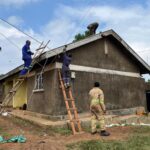Task 247
GPM Algorithm Development
Principal Investigator(s):
J. Munchak
Sponsor(s):
A. Hou
Last Updated:
October 26, 2012 15:26:13
Description of Problem
The general objective is to develop a general framework and state-of-the-art algorithms to advance precipitation observations from space using information from active and passive microwave sensors. In particular, two areas of investigation have been selected: 1) Support of the falling snow portion of the GPM passive radiometer algorithm; and 2) assessing the information content of combined dual-frequency radar and multichannel radiometer measurements of clouds and precipitation.
Scientific Objectives and Approach
In support of the GPM Microwave Imager (GMI) algorithm, the capability of GMI to detect precipitation (both liquid and frozen) over a variety of surface types, including (but not limited to) water, bare land, snow-covered land was assessed. In order to replicate GMI observations as closely as possible, existing sensors (SSMIS, AMSR-E, AMSU-B, and MHS) were used. Ground truth for precipitation detection comes from active sensors such as the NOAA National Mosaic and QPE (NMQ) product over the continuous US and CloudSat globally. The essence of the approach is to evaluate a set of GMI-equivalent brightness temperatures for consistency with a non-precipitating atmosphere. This requires a priori knowledge of the means and covariances of surface emissivity (we use a physical model over ocean and the TELSEM climatology over land) and atmosphere (climatology from MERRA re-analysis) parameters combined with a radiative transfer model. This approach has the advantage of not requiring a database of precipitation profiles as in Bayesian algorithm; these databases are still under development for GPM and provides for an evaluation of the improvement from real-time vs. ancillary data sources (such as NWP data vs. climatology for atmospheric parameters).
In support of the GPM combined radar-radiometer algorithm development, the focus is on the sensitivity of algorithm output (primarily rain rate, although secondary parameters are also examined) to the initial assumptions. Because a GPM-like platform does not yet exist on a satellite, data from GRIP, MC3E, and GCPEX field campaigns, all of which contain co-located Ku/Ka band radar data and at least a partial set of GMI channels, will be used to mimic observations. In-situ observations from these campaigns will also be used to construct optimal parameterizations of hydrometeor size distributions and cloud vertical profiles.
Accomplishments
The ability of the AMSU-B/MHS to identify precipitation over various surfaces is illustrated in Figure 1. The metric used to evaluate skill is the Heidke Skill Score (HSS). Best detection occurs over the ice-free where physical emissivity models are relatively mature. Over more complex surfaces, detection is limited to heavier precipitation and skill is generally lower. In particular, there is no skill over the ice sheets although this may also be due to a lack of sufficiently heavy precipitation in these regions to produce a detectable signal.
We have also evaluated the improvement in skill that comes from the use of a real-time (vs. climatological) atmospheric state and use of a snow emissivity database in place of TELSEM when snow is analyzed on the ground (Figure 2). The addition of MERRA greatly improves the skill for instruments with sounder channels (GMI and SND), whereas the conditional snow emissivity database provides the best improvement for instruments with surface-sensitive channels (TMI and GMI).
As a side product of this analysis, a high-frequency (> 100 GHz) emissivity database was developed in order to complement the TELSEM (Tool to Estimate Land Surface Emissivity in the Microwave) database, which is a 10+ year climatology of land surface emissivity from SSM/I. High-frequency emissivities are particularly important in cold and dry environments, where water vapor emission does not entirely obscure the surface. These have been used by various members of the GPM passive microwave algorithm team in developing model-based Bayesian databases for GMI. Another side product being used by the GPM radiometer algorithm team is a Bayesian database of SSMIS brightness temperatures and co-located NMQ precipitation rate.
The combined algorithm information content analysis has been performed with data from GRIP and MC3E thus far. As an example the sensitivity of the retrieved median raindrop diameter to initial assumptions is shown in Figure 3. Three regimes are apparent below the melting layer:
1. Very light rainfall (leading edge of storm; < 1 mm/hr). Here D0 is poorly constrained because Ka and Ku bands wavelengths do not contain independent information.
2. Light-moderate rainfall (1 mm/hr < R < 25 mm/hr). Here D0 is well constrained (white region in lower panel indicates no sensitivity to initial assumption).
3. Heavy rainfall (R > 25 mm/hr). Here the dual-wavelength retrieval algorithm becomes numerically unstable. Alternate approaches (bottom-up Hitschfeld-Bordan) are being pursued to mitigate this problem.
Other Publications and Conferences
Munchak, S.J., G. S. Jackson, B. T. Johnson, 2011: Thresholds of Passive Microwave Snowfall Detection Determined Using CloudSat and AMSU-B. European Geosciences Union General Assembly, Vienna, Austria, April 4-8, 2011
Munchak, S. J., G. S. Jackson, B. T. Johnson, 2012: Thresholds of Passive Microwave Snowfall Detection Determined Using A-Train Observations. 18th Conference on Satellite Meteorology, Oceanography, and Climatology, New Orleans, LA, 22-26 January 2012
Munchak, S. J., M. Grecu, W. S. Olson, 2012: Information Content of Combined Dual-Frequency Radar and Radiometer Observations from GPM. 18th Conference on Satellite Meteorology, Oceanography, and Climatology, New Orleans, LA, 22-26 January 2012







